You unlock this door with the key of imagination. Beyond it is another dimension: a dimension of sound; a dimension of sight; a dimension of mind. You’re moving into a land of both shadow and substance, of things and ideas; you’ve just crossed over into… The Twilight Zone.
Looming over the movie palaces and marketplaces of Sunset Blvd. stands a lost icon; the lightning-scarred shell of the once-glamorous Hollywood Tower Hotel. Its neon sign sparking, this decripid, imposing tower may not look like a beacon for the showbusiness elite, but something is indeed about to happen that will change all that.
Though guests may have quickly abandoned this supernaturally haunted hotel on Halloween Night, 1939, a new generation of visitors flock to its misty grounds today, eager to take on one of the most spectacular Modern Marvels in all of Disney Parks history.
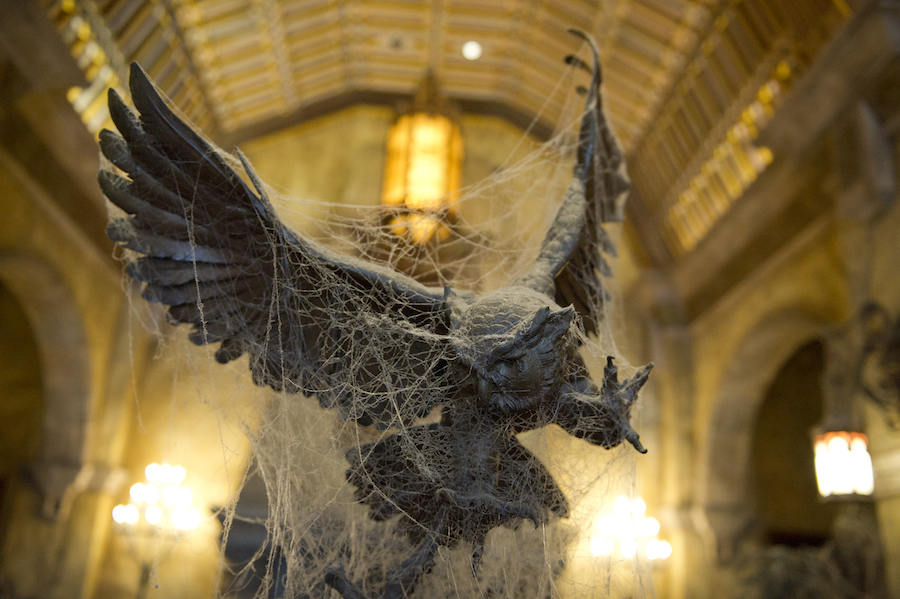
Submitted for your approval: the tale of The Twilight Zone Tower of Terror, the industry-changing E-Ticket dark ride that continues to define Disney’s Hollywood Studios theme park. This immersive, cinematic, gut-wrenching journey into the fifth dimension is one of the most legendary, sought-after, and mysterious attractions ever designed by Disney Imagineers; a fan-favorite that stands among the greatest rides on Earth. You may think you know the story, but there’s so much before “Hollywood, 1939…”
In this in-depth feature, we’ll explore how Imagineers decided on and developed a drop ride, what chilling mysteries awaited within the haunted Hollywood Tower Hotel, what made California’s Tower so essential to the park’s narrative and rebirth, and what took the place of this storytelling marvel. It’s a tale so unbelievable with such an unimaginable twist ending, it can only be a story told from the outer reaches of… The Twilight Zone.

Thank you so much for reading. Now, it’s your turn to join the story. If you enjoy spending time falling down the “rabbit hole” of Park Lore’s in-depth, ad-free, member-supported stories, consider becoming a Member for as little as $2 / month.
Members can unlock rare concept art in every tale, reveal attraction audio streams in select stories, gain access to over a hundred exclusive articles in our quick-read Extra Features and in-depth Special Features collections, gain exclusive podcast extras, and receive an annual member card and merch in the mail! (Plus, y’know, supporting research-based, ad-free, clickbait-free, in-depth theme park writing!)
History in Freefall
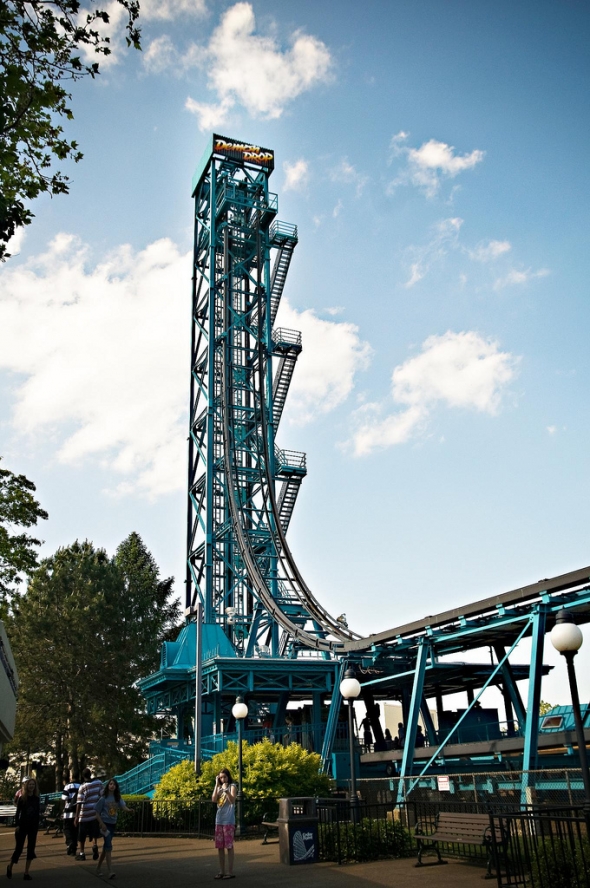
As is usually the case with our in-depth stories, the story begins long before the Tower of Terror carried its first passengers into another dimension. The idea of incorporating a freefall drop ride into a Disney park is as old as the technology that could’ve made it happen.
In 1982, Six Flags Magic Mountain California opened Freefall, a first generation Intamin Freefall tower. The mechanics behind the ride were cutting edge. Four guests would strap into a cart that slowly advanced backward into the base of a steel tower. The cart would then be lifted up to the height of the tower and gently pushed forward, precariously perched high above the park.
Aligned perfectly with the outside of the tower, the cart would release and careen down the vertical drop, sliding out at the bottom of the curved track so riders would end up on their backs, reversing backwards to the loading area. Truly, the process has to be seen to be believed.
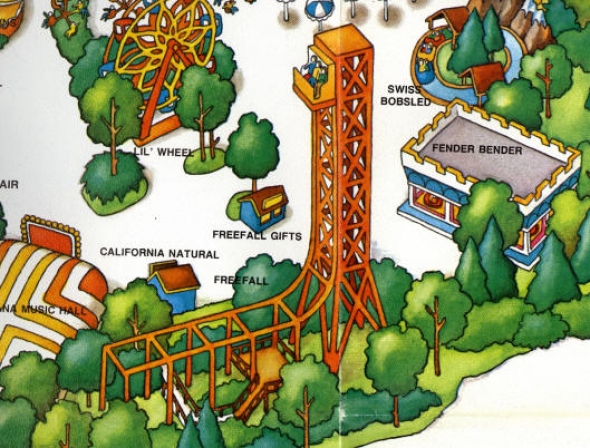
The mechanics might seem rudimentary or even barbaric by today’s standards, but the cutting edge technology caught the world by storm. Guests queued for hours to experience the 20-second ride at Magic Mountain, and the ride was quickly duplicated at thrill parks across the world. In the mid-1980s, Disney was poised to incorporate this brand new experience into their parks, as well.
Both EPCOT Center and Tokyo Disneyland opened within six months of each other (in October 1982 and April 1983, respectively), right about the same time that Six Flags’ Freefall debuted. And just then, everything changed.
“Rise of the Movies”
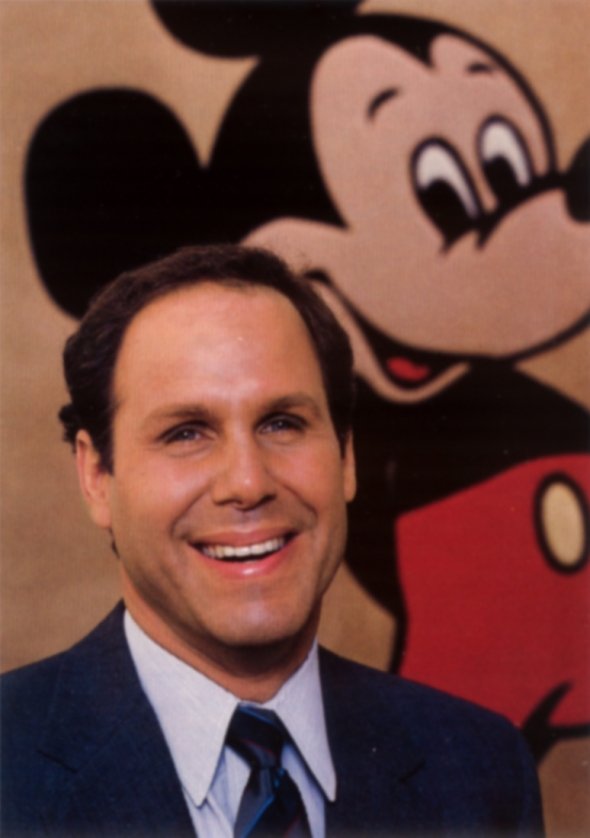
It will be no surprise to frequent Park Lore reachers that the story of the Twilight Zone Tower of Terror hinges on that ever-pivotal figure at Disney in the ’80s and ’90s: Michael Eisner. Eisner had arrived to Disney in 1984, taking on the Chairman role at Disney’s most depserate hour. With decades of declining returns at the box office and seriously stagnating theme parks, Eisner’s job was essentially to right the ship; to revive the studios; to reinvigorate the parks; to save Disney.
Given Eisner’s particularly cinematic background (he’d worked his way through Paramount’s television, then film divisions before ultimately being named CEO of Paramount), he was just the man for the job. Under Eisner’s watch, the Disney Renaissance remade the company’s name in pop culture and revived the abandoned art of animation. Similarly, Eisner was known to make frequent trips to the Imagineering division in Glendale, California, where he was willing to invest in big, ambitious projects not seen since Walt’s time.
However, Eisner famously had some requirements. First, he wanted desperately to put Disney Parks in high gear. Though the quaint amusements of Walt’s time had been sweet and historic, the ’70s and ’80s had seen the proliferation of amusement parks across the country, offering high-thrill roller coasters, drop towers, and flat rides. For Disney’s theme parks to stay competitive, they needed to change by becoming thrilling, high-energy, record-breaking places where every member of the family – even teenagers – found something to love.
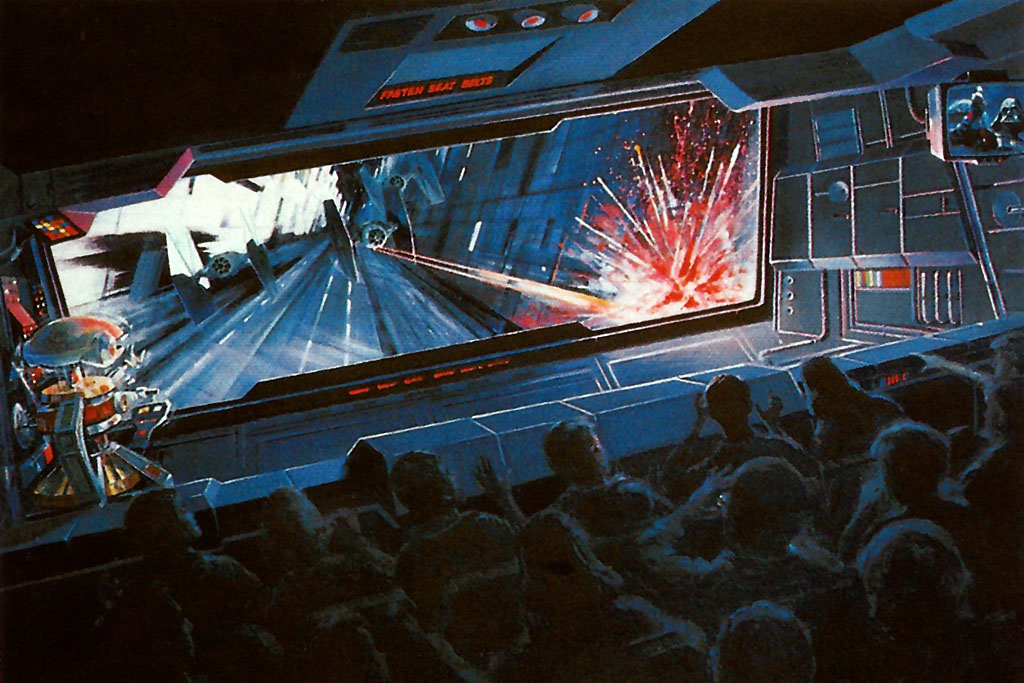
Second, he believed that Disney Parks needed to stay fresh by incorporating cool, hip, modern heroes, stories, settings, and characters that mattered to audiences today… even if they weren’t Disney characters! And thanks to his studio connections, Eisner was able to forge partnerships with famous filmmakers and stars of the day to do just that… It’s why the first products from Eisner’s tenue were the Lost Legends: Captain EO and STAR TOURS (through a partnership with Star Wars creator George Lucas), each a step in making Disney Parks must-see Meccas for pop culture staples.
In fact, we traced this big-budget blockbuster “Ride the Movies” era of Imagineering in its own Special Feature – a must-read for industry fans.
By the end of he ’80s, Eisner had Imagineering working overtime on two monumental new theme parks, each meant to cement his young legacy with the company. And to his thinking, a high-thrill freefall attraction could be incorporated in both…
Discovery Mountain
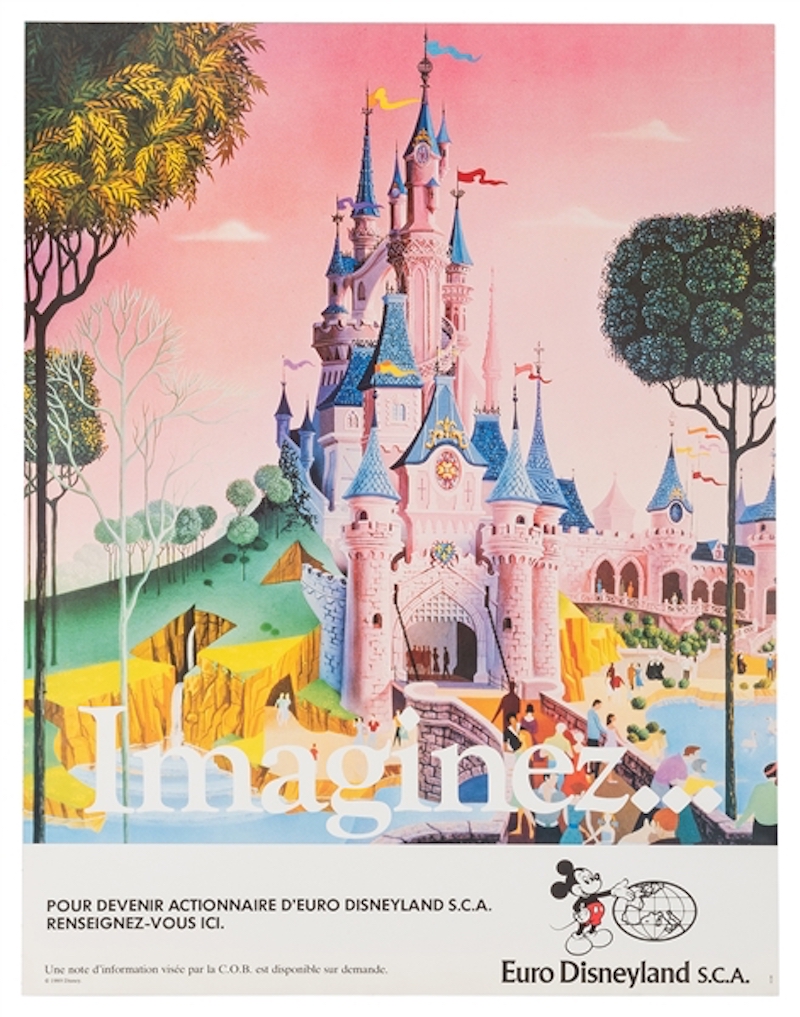
To hear Disney historian Jim Hill tell it, Imagineers at once got to work developing ideas for how to incorporate that simple, off-the-shelf drop tower thrill ride into Disney Parks in their usual, story-centered way. Luckily, they had an opening. EuroDisneyland was going to be different from anything Disney had done before.
Establishing the EuroDisney Resort just outside of Paris would give Disney a foothold in Europe, no more than a four-hour drive for 68 million people and no more than a two-hour flight for a further 300 million. The potential was endless.
Of course, so where the risks. The French media famously set their sights on destroying EuroDisneyland, rallying the public against the invasion of “American imperialism” and the audacity of building such an inherently-American creation as Disneyland near the City of Lights. Despite the fervor, Disney Imagineers were anticipating making major changes to the Disneyland formula in order to be culturally relevant (and respectful) in Europe. In fact, each of EuroDisneyland’s themed areas were reimagined to downplay excessive Americana and replace it with more lush, rich, literary, European sources of inspiration.
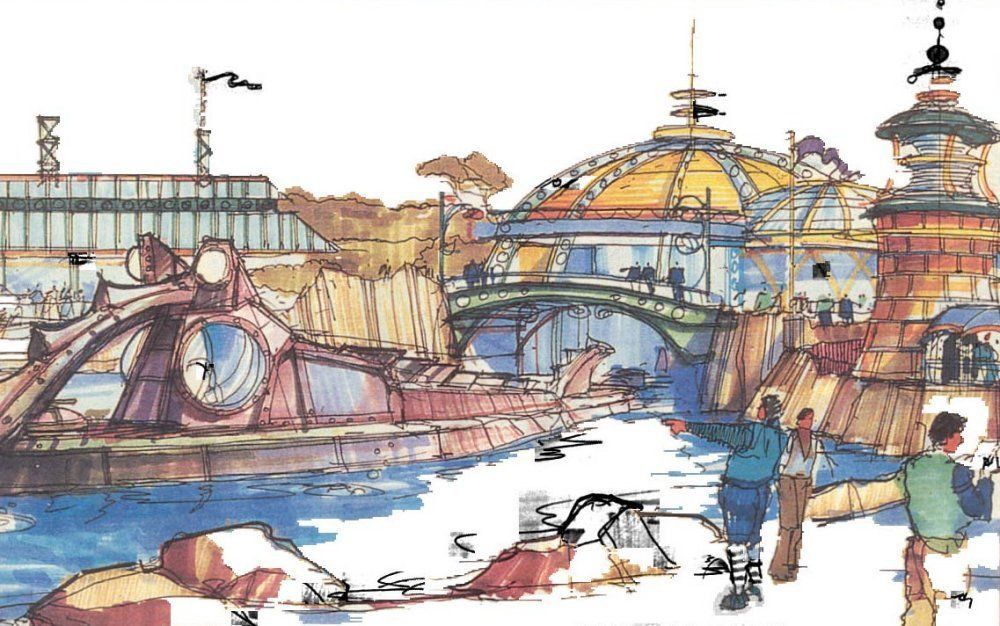
Among its revolutions would be Discoveryland – a new take on Tomorrowland, recast as a timeless realm disconnected from actual science in favor of the retro-futurism of great European literary thinkers. In this golden, steampunk-stylized look at the future as rooted in the past, guests would find attractions themed to the works of Jules Verne and H.G. Wells. In fact, when the park opened in 1992, its uniquely European anchor was the Lost Legend: Le Visionarium – a journey through time with Jules Verne in tow.
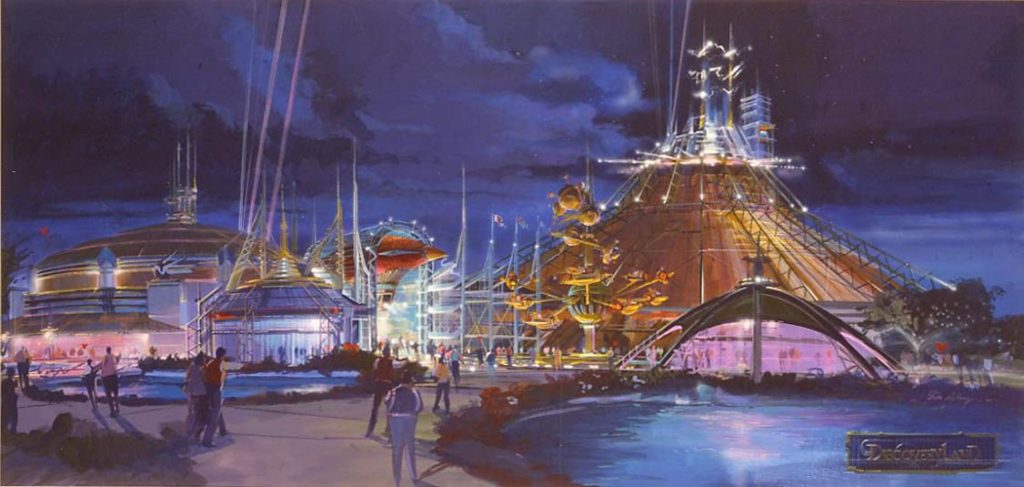
But behind the scenes, Imagineers were crafting plans for an industry-changing attraction that would act as the park’s one-of-a-kind centerpiece.
Discovery Mountain would’ve been more than just a Parisian overlay of Space Mountain; it would’ve been a stunning, massive indoor complex – a land within the land. Discovery Mountain would’ve been on a scale never seen before – twice the diameter of any existing Space Mountain. It would’ve been a pavilion in its own right, ushering guests into the secret lair of Jules Verne’s antihero Captain Nemo, beneath perpetual night skies…
Journey to the Center of the Earth
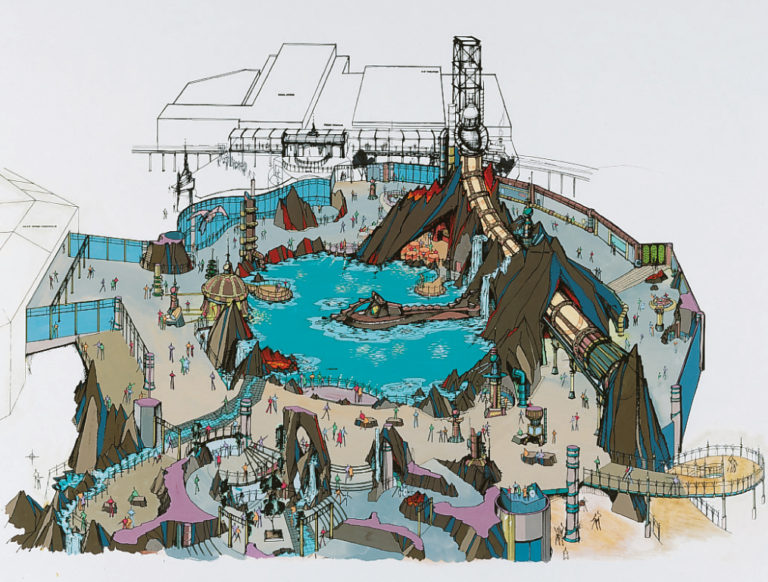
And there, in the center of this massive indoor environment would stand an Intamin first generation Freefall ride. Themed to Verne’s Journey to the Center of the Earth, the ride would hoist guests sky-high, up and out of Discovery Mountain (see if you can spot it in the concept painting of Discoveryland) in a makeshift Victorian drilling device.
Then, having been rewarded with views across the resort, the cab would be pushed out of the tower to plunge back into Discovery Mountain, sliding toward an open lava vent, with bursts of steam and fire accompanying the descent.
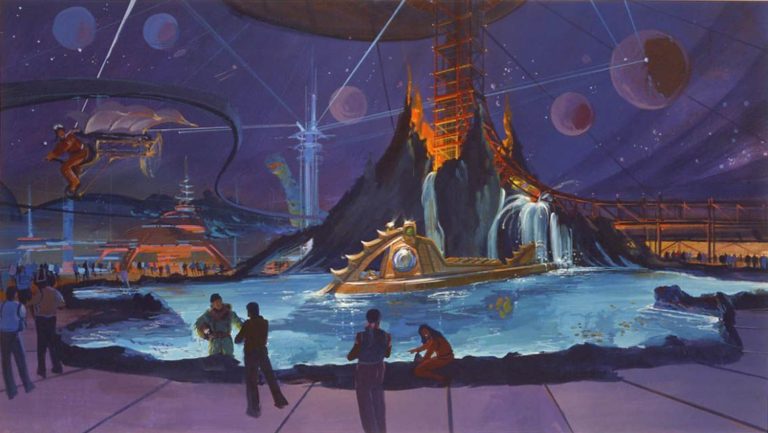
Of course, at the last second, the elevator would slide out and splash through a volcanic basin, running out its energy beneath the mountain’s starry skies. Guest would then be lowered back into the iron lattice tower and returned to the station for unloading.. Sure, this early idea of a drop ride would’ve been a mostly-bare steel thrill ride. However, the smart concept “disguised” Intamin’s ride in plain sight – as a retrofuturistic, red iron drilling machine within the steampunk industrial environment of the mountain.
Discovery Mountain didn’t happen, though. Instead, Paris’ ride was downsized to Space Mountain-scale, albeit with a fantastic, one-of-a-kind overlay – the Lost Legend: Space Mountain – De la Terre a la Lune.
In retrospect, we can be glad Disney didn’t move forward with this drop tower – after all, most of the once-widespread installations of this first-generation ride have since been replaced with more modern variations, and the few that do remain feel downright rickety in comparison. But the idea stuck, and Disney Imagineers doubled down on their insistence that a drop ride could belong at a Disney Park.
Luckily, the concept was stll on the table for the other park Disney had designed in the era… and in fact, at the Disney-MGM Studios, it was needed more than ever. Read on…



